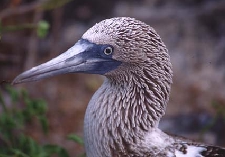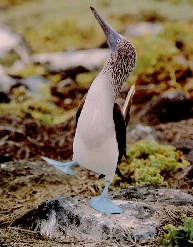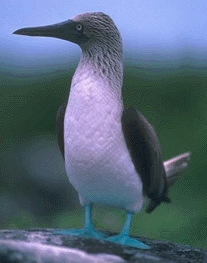The Blue-Footed Booby

 With thick white feathered streaks on the pale cinnamon-brown head, and brown pointed wings, the bluefoot has a cigar-shaped body when stationary.
With thick white feathered streaks on the pale cinnamon-brown head, and brown pointed wings, the bluefoot has a cigar-shaped body when stationary.The bluefoot derives it's name booby from the Spanish word bobo meaning stupid fellow. This is the general perception of the bird because of the lack of fear it shows around people, and it's clumsy-looking walk on land.
 Clumsy is not the word for it's hunting skills however. The birds diet consists mainly of fish, and has a very efficient diving technique in which it shoots into the water from some very startling heights (up to 80 feet above the water) to snatch up the fish with its pointy serrated bill. Along with this technique, the bluefoot can do what most other birds cannot, that is, dive from a swimming position to feed as well.
Clumsy is not the word for it's hunting skills however. The birds diet consists mainly of fish, and has a very efficient diving technique in which it shoots into the water from some very startling heights (up to 80 feet above the water) to snatch up the fish with its pointy serrated bill. Along with this technique, the bluefoot can do what most other birds cannot, that is, dive from a swimming position to feed as well. Thanks to wildlife endangered species cards mailed to me as a child, and some friendly adolescent nicknaming, Bobby became booby, with an addition of Blue-footed, shortened to Bluefoot, and generally now shortened to Blue.
Thanks to wildlife endangered species cards mailed to me as a child, and some friendly adolescent nicknaming, Bobby became booby, with an addition of Blue-footed, shortened to Bluefoot, and generally now shortened to Blue.